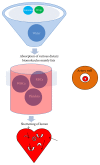Emerging risk biomarkers in cardiovascular diseases and disorders
- PMID: 25949827
- PMCID: PMC4407625
- DOI: 10.1155/2015/971453
Emerging risk biomarkers in cardiovascular diseases and disorders
Abstract
Present review article highlights various cardiovascular risk prediction biomarkers by incorporating both traditional risk factors to be used as diagnostic markers and recent technologically generated diagnostic and therapeutic markers. This paper explains traditional biomarkers such as lipid profile, glucose, and hormone level and physiological biomarkers based on measurement of levels of important biomolecules such as serum ferritin, triglyceride to HDLp (high density lipoproteins) ratio, lipophorin-cholesterol ratio, lipid-lipophorin ratio, LDL cholesterol level, HDLp and apolipoprotein levels, lipophorins and LTPs ratio, sphingolipids, Omega-3 Index, and ST2 level. In addition, immunohistochemical, oxidative stress, inflammatory, anatomical, imaging, genetic, and therapeutic biomarkers have been explained in detail with their investigational specifications. Many of these biomarkers, alone or in combination, can play important role in prediction of risks, its types, and status of morbidity. As emerging risks are found to be affiliated with minor and microlevel factors and its diagnosis at an earlier stage could find CVD, hence, there is an urgent need of new more authentic, appropriate, and reliable diagnostic and therapeutic markers to confirm disease well in time to start the clinical aid to the patients. Present review aims to discuss new emerging biomarkers that could facilitate more authentic and fast diagnosis of CVDs, HF (heart failures), and various lipid abnormalities and disorders in the future.
Figures






References
-
- Bamba V. Update on screening, etiology, and treatment of dyslipidemia in children. The Journal of Clinical Endocrinology & Metabolism. 2014;99(9):3093–3102. - PubMed
-
- Cooper J. A., Miller G. J., Humphries S. E. A comparison of the PROCAM and Framingham point-scoring systems for estimation of individual risk of coronary heart disease in the Second Northwick Park Heart Study. Atherosclerosis. 2005;181(1):93–100. doi: 10.1016/j.atherosclerosis.2004.12.026. - DOI - PubMed
Publication types
LinkOut - more resources
Full Text Sources
Other Literature Sources
Research Materials
Miscellaneous

